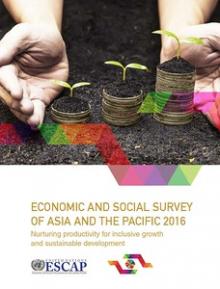
As nations begin implementing the 2030 Agenda for Sustainable Development, the next phase of Asia-Pacific economic growth should be driven by broad-based productivity gains, the United Nations Economic and Social Commission for Asia and the Pacific (ESCAP) said in its flagship publication Economic and Social Survey for Asia and the Pacific 2016 launched today, emphasizing that this will require higher, targeted fiscal spending, enhanced skills, better infrastructure, and improved agricultural productivity.
In the developing countries of Asia and the Pacific, annual average growth of total factor productivity declined from 2.8 per cent in 2000-2007 to just below 1 per cent in 2008-2014, according to the Survey.
The productivity slowdown accounts for almost a fifth of the recent economic slowdown, from an average of 9.4 per cent during 2005-2007 to an estimated 4.6 per cent growth in 2015. ESCAP underscores that this is a concern because sustained and resilient economic and productivity growth, backed by balanced economic, social and environmental development, is a prerequisite for successful implementation of the 2030 Agenda.
Launching the Survey in Bangkok, Dr. Shamshad Akhtar, United Nations Under-Secretary- General and ESCAP Executive Secretary emphasized that steady growth in real wages, which is critical for tackling poverty and inequality, as well as supporting domestic demand, also ultimately depends on productivity growth.
“Concerted efforts are needed to revive the region’s economic dynamism and more effectively pursue the 2030 Agenda,” said Dr. Akhtar. “Such interventions, particularly through fiscal measures, could support not only domestic demand but also strengthen the foundations for productivity-led growth, while fostering real demand through social safety nets and wage increases.”
Noting that the Asia-Pacific region has the means and dynamism to revive economic growth, Dr. Akhtar acknowledged that: “Improving the quality of this growth by making it more inclusive and sustainable, will be especially demanding.”
The Survey calls for continued rebalancing towards domestic and regional demand, as prospects for export-led growth remain subdued. A confluence of macroeconomic risks including shifts in global financial and commodities cycles has also increased uncertainty. The Survey highlights that despite emerging challenges the region’s economic outlook is broadly stable and forecasts a moderate pickup in economic growth in developing Asia and the Pacific to 4.8 per cent in 2016 and 5 per cent in 2017.
The Survey notes that progress in reducing poverty is slowing and inequalities are rising in much of the region. At the same time, an expanding middle class and rapid urbanization are posing complex economic, social, environmental and governance challenges. The region also faces increased financial volatility and capital outflows, which have limited the space for monetary policy manoeuvring, despite low overall inflation. Several countries are also experiencing a private debt overhang after rapid increases in household and corporate leverage in recent years.
ESCAP recommends that if the region is to shift to a more sustainable development strategy driven by domestic demand, greater focus must be placed on productivity along with commensurate increases in real wages. According to ESCAP, a productivity-driven, wage-led approach would enable countries to increase their aggregate supply and demand, thereby enhancing well-being.
To boost productivity, the Survey recommends a cross-sectoral and integrated approach. It notes that several countries in the region are deindustrializing too early in their development, by shifting from agriculture-based economies to ones in which services play a dominant role. With more than half of the region’s population living in rural areas, and four out of ten workers engaged in agriculture, efforts should instead be strengthened to boost agricultural productivity and foster rural industrialization and urban-rural linkages. The Survey estimates that a modest increase in agricultural productivity could lift an additional 110 million people out of poverty by 2030, but that improvements in knowledge and skills will be critical, to enable absorption of the large pools of surplus labour that are being released in the rural sector.
Identifying the important role of fiscal policy in reviving economic growth and supporting the 2030 Agenda, Dr. Akhtar emphasized that: “Fiscal initiatives should be underpinned by sustained reforms towards an efficient and fair tax system that delivers the necessary revenues and promotes equity.”
Given the Asia-Pacific region’s diversity, the Survey also highlights specific policy issues, such as improving female labour participation in South and South-West Asia; enhancing resilience to natural disasters in the Pacific; dealing with population ageing challenges in East and North-East Asia; economic diversification and services sector development in North and Central Asia; as well as tax policy and administration reforms in South-East Asia.
The Economic and Social Survey of Asia and the Pacific is being launched simultaneously in 24 countries around the Asia-Pacific region. The year-end update of the Survey will be released in November 2016.
For a full copy of the survey visit: http://www.unescap.org/publications/economic-and-social-survey-asia-pacific





